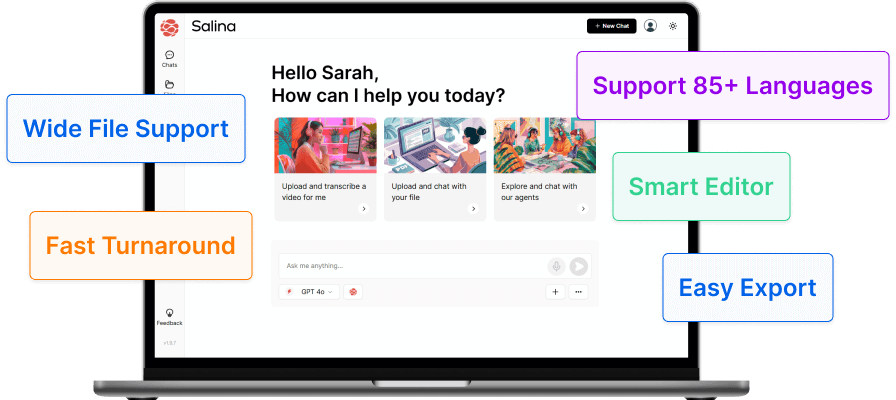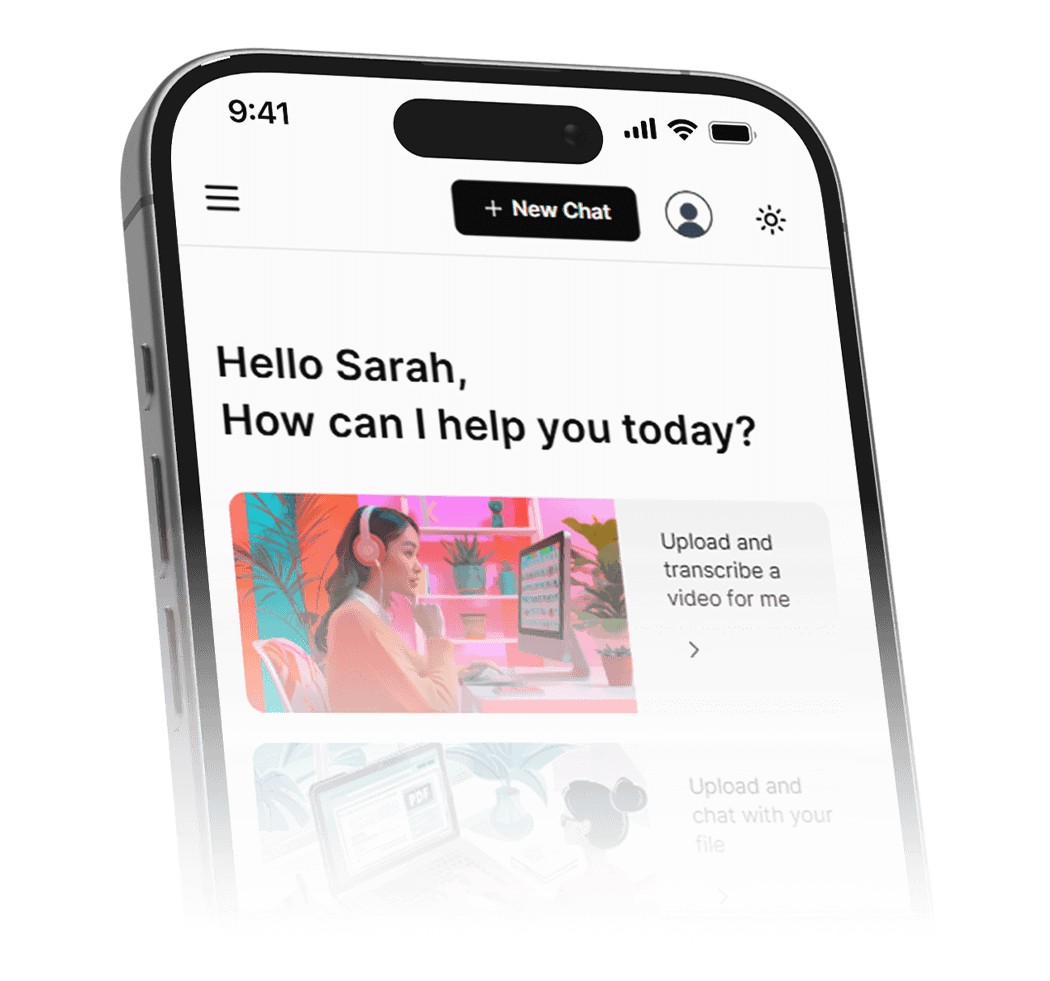Level up your content creation! This guide unlocks practical AI writing tips and tricks to boost your efficiency and spark fresh ideas. Write faster, create variety, and keep your content flowing.
If you’re a content writer in the age of AI you should be less concerned about how AI might replace you, but rather be more curious as to how it can augment your abilities to craft better-written content.
Let me feed your curiosity as we go through these questions together!
- How can I beat writer’s block with the use of AI?
- Can I use AI to be my research assistant in my writing process?
- What AI tool can I use to match the tone I have in my writing?
- What should I be wary of when using AI to help me write?
Why does AI Writing Matter?
AI writing is important for a few reasons that affect both content writers and creators. AI writing tools help make writing faster and better by making the process smoother, assisting with coming up with ideas and improving understanding. These tools can help writers get past writer’s block, create content consistently, and produce good text quickly, which boosts productivity and helps meet deadlines. They also help improve writing quality by analyzing data, spotting patterns, and making sure content is error-free.
Despite these benefits, AI writing tools do have limits, like not being as creative as human writers, which could mean losing some individuality and creativity. While there are concerns, like those mentioned by The New York Times, about AI taking over writing, it’s important to remember that AI tools are meant to enhance human creativity, not replace it. The essence of writing—conveying ideas, solving problems, and communicating effectively—remains a uniquely human strength, as underscored by articles from sources like ECO Canada.
How AI Can Assist in Generating Compelling Content
AI’s capacity to assist in generating compelling content lies in its ability to process vast amounts of data and provide insights that might not be immediately apparent to human writers. However, as Jessica Stillman points out in Inc., writing remains a critical tool for personal and professional development, serving as a mirror to our thoughts and a pathway to deeper understanding (Inc.).
In conclusion, while AI writing tools present new opportunities and challenges, the essence of writing as a reflection of human thought, emotion, and creativity remains unchanged. As we navigate this AI-infused landscape, it’s crucial to remember the words of Jim White on LinkedIn, who reminds us that writing, with its unique voice and human touch, still matters in an AI world (LinkedIn). The integration of AI into the writing process should not be seen as a threat but as an evolution—a chance to redefine and enrich the art of writing for the modern age.
The 10 Essential AI Writing Tips and Tricks for Content Writers
Content creation is both an art and a science, especially with Artificial Intelligence (AI) emerging as a powerful tool to enhance the creative process. However, making use of AI effectively requires a blend of strategy and creativity. Here are ten essential tips and tricks to help content writers integrate AI into their workflow, ensuring both efficiency and quality in their output.
1. Craft Clear Instructions
The precision of your input to an AI determines the quality of its output. When using AI writing tools, it’s crucial to provide concise and specific prompts. This clarity helps the AI understand exactly what you’re looking for, resulting in content that aligns more closely with your expectations. Think of it as giving directions; the more detailed they are, the less likely you are to get lost.
The LinkedIn post below by former Fortune 500 leader and career coach Kathryn Montbriand highlights the different uses of prompts to aid her in writing. Montbriand emphasizes that while AI tools can enhance efficiency, they should complement rather than replace the human touch in content creation. Her insights offer valuable perspectives on maximizing AI as support, not substitute, the creative process. Explore her full thoughts here:
For instance, consider these examples of prompts:
- Effective Prompt: “Generate a recipe for a vegan lasagna, including a list of ingredients, step-by-step instructions, and cooking tips.”
- Ineffective Prompt: “Write something about food.”
The effective prompt provides clear direction on the specific dish to be created, along with the necessary components and structure. In contrast, the ineffective prompt lacks specificity, leaving the AI tool to guess the writer’s intentions, potentially resulting in irrelevant or unfocused content.
Common Pitfalls:
When crafting prompts for AI writing tools, it’s important to avoid common pitfalls such as:
- Vagueness: Providing overly general prompts without specific details or objectives.
- Complexity: Using technical language or convoluted instructions that confuse the AI tool.
- Unrealistic Expectations: Requesting content beyond the capabilities of the AI tool or expecting it to fully understand nuanced topics without sufficient guidance.
To avoid these pitfalls, writers should strive for clarity, simplicity, and realism in their prompts. Clearly define the desired outcome, provide context where necessary, and keep instructions straightforward to ensure optimal results from AI writing tools.
2. Use AI as a Research Assistant
Diving into research can often feel like falling down a rabbit hole, consuming hours that could be better spent writing. This is where AI comes in handy. Maximize the use of AI tools to quickly gather relevant data, statistics, and sources. By delegating the initial research phase to AI, you can focus more on crafting compelling narratives with the information it retrieves.
With the right AI tools at your disposal, you can transform this challenging task into a smooth and efficient process. Here are two standout options that have changed my approach to research
🎉 Dive into Monica4.0 on Product Hunt! And guess what? A thrilling discount awaits inside the article! 🎁🤑️
— Monica_IM (@hey_im_monica) December 28, 2023
👍 Like our story? Tap that UPVOTE, boost the buzz, and be our hero! 🌟https://t.co/ataFWbkBct
3. Beat Writer’s Block
Every writer knows the dread of facing a blank page. AI can be a lifeline in these moments, offering a starting point for your creativity. Use AI to generate questions, content angles, or even rough drafts based on your topic. These prompts can kickstart your thought process, helping you overcome writer’s block and get those creative juices flowing.
Exploring the potential of AI as a tool to conquer writer’s block further, this Reddit post dives into real-life experiences of individuals using ChatGPT as a remedy for this common challenge. It provides insights and discussions that can enrich our understanding of how AI can serve as a catalyst for creativity.
4. Find Your Content Voice
Consistency in tone is key to establishing your brand’s voice. AI writing tools often include settings that allow you to choose from various writing styles, such as casual, formal, or creative. Selecting the appropriate style for your content ensures that the AI-generated text matches the tone you’re aiming for, whether it’s a blog post, report, or social media update.
Building on the importance of finding and maintaining your content voice, Jasper emerges as a powerful tool when it comes to AI writing. Its Brand Voice feature specifically addresses the challenge of ensuring all AI-generated content aligns with your brand’s identity, tone, and style.
While Jasper excels at crafting varied content like blogs and social media posts, it’s the ability to learn and incorporate your brand’s specific details—ranging from company facts to product catalogs—that sets it apart. This deep understanding facilitates the creation of content that rarely needs heavy editing to reflect your brand accurately. Jasper not only offers a range of writing styles and tones but, more importantly, it enables a seamless and authentic expression of your brand’s voice across all communications.
5. Reprompt for Further Improvement
Not satisfied with the first draft? That’s perfectly normal. AI is all about iteration. If the initial output doesn’t hit the mark, tweak your instructions or ask the question differently. This process encourages the AI to explore other directions, providing you with new variations that might better fit your requirements.
To illustrate the power of reprompting in AI-assisted writing or iterative improvement as others might refer to it, let’s explore an example where AI is prompted to draft a blog introduction.
Initial Prompt: “Write an introduction for my blog post.”
Instruction: Specify the blog post’s topic to guide the AI towards relevance and focus.
Iteration 1: “Can you write an introduction for a blog post about the benefits of meditation?”
Instruction: Add a desired tone or style to the prompt to further refine the output, such as informative, casual, or inspirational.
Iteration 2: “Craft an informative yet engaging introduction for a blog post on the benefits of meditation, aiming to inspire beginners to start their practice.”
Instruction: Incorporate a specific angle or question that the blog aims to address, adding depth to the introduction.
Iteration 3: “I need an engaging introduction that discusses how meditation can transform daily stress into tranquility, specifically tailored for beginners. How can meditation become their secret weapon against stress?”
Instruction: Request the inclusion of a personal anecdote or a hypothetical scenario to make the introduction more relatable and captivating.
Iteration 4: “Let’s make the introduction more personal. Can you include a short anecdote about someone finding solace in meditation amidst a hectic work life, illustrating its benefits for managing stress?”
Instruction: Evaluate the effectiveness of the introduction in capturing attention and setting the tone for the blog. Use feedback to refine the approach, such as emphasizing certain benefits or using more vivid imagery.
Iteration 5: “Reflecting on the previous introductions, let’s focus more on vivid imagery and compelling benefits. How about starting with a vivid description of a moment of peace through meditation in a chaotic city life, highlighting its immediate calming effects?”
Each iteration refines the prompt, guiding the AI to produce a more specific, engaging, and tailored introduction. This process not only enhances the quality of the content but also ensures that it aligns closely with the writer’s vision and the audience’s expectations.
6. Double-Check the Facts
While AI can be incredibly resourceful, it’s not infallible. Always take the time to verify the facts and data provided by AI tools. Fact-checking is essential to maintain your credibility and ensure the accuracy of your content. This diligence protects your reputation and builds trust with your audience.
Fact-checking is an essential step in content creation, especially with AI in the mix. It ensures our work stays accurate and trustworthy. Ben Riggs brings this point home on LinkedIn, where he highlights the importance of human oversight in AI-generated content. His post isn’t just insightful—it also tips its hat to Lisa McLendon’s original discussion on Poynter about why editors and fact-checkers are important, even in the age of AI. McLendon’s piece is a must-read for anyone looking to understand the depth of this issue. Check out Riggs’ post for a quick overview and a link to McLendon’s full article below.
7. Edit Like a Pro
Think of AI-generated content as your first draft. It’s not ready to go out into the world just yet. You’ve got to dive in and make it better. This means fixing any issues, making sure it flows nicely, and ensuring it sounds like you or your brand. It’s all about adding that human touch to take it from something basic to something that really grabs people.
Yunhao Zhang has an interesting point that ties into this. He talks about how we usually focus on what AI can do for us, like making jobs easier or sparking new ideas. But, he reminds us that what really matters is if people actually like what AI creates.
“Ultimately, the work that AI does will be judged by whether or not consumers like it.”
Yunhao (Jerry) Zhang – SM ’20, PhD ’23, a postdoctoral fellow at the Psychology of Technology Institute.
That’s where you come in. By editing the AI’s work, you’re making sure it fits what your audience wants. In a way, you’re the final check to make sure AI is actually helpful and enjoyable for people to read.
8. Target Your Audience
When you’re making content, knowing who you’re talking to is key. Think about what your readers like, what they need, and what catches their attention. When you set up your AI to help with writing, make sure you’re telling it exactly who your audience is. This way, the stuff it helps you create will hit the mark, making your readers feel like you’re talking right to them. This isn’t just nice for them; it makes them want to stick around, boosting their connection to your content.
I stumbled upon a fascinating blog by Casper, the mattress brand, which cleverly targets dog owners. The blog delves into dog sleeping positions and their meanings, offering insights that resonate with pet enthusiasts. It’s a smart way to link their content to their product offerings, like dog beds, by engaging readers with relatable, valuable information.
Check out the blog here: 17 Best Content Marketing Examples to Boost Your Creativity
This successful approach shown by the blog’s engagement above exemplifies how brands can use content to connect with specific audience segments, guiding similar strategies for creating engaging, targeted content using AI for insights and personalization.
Much like Casper’s blog on dog sleeping positions has successfully engaged dog owners, you too can create content that deeply resonates with your audience. The question is how? AI-driven insights and content personalization can be taken advantage of here by making use of tools such as:
Jasper • for creating tailored content.
Surfer SEO • for optimizing your content strategy based on AI analysis.
PaveAI • turns Google Analytics data into actionable insights with AI.
9. Don’t Lose Your Voice
Remember, AI is a tool for brainstorming and efficiency—it’s not a substitute for your expertise and unique perspective. Your personal insights, experiences, and voice are what set your content apart. Use AI to support your ideas, but make sure the final piece reflects your individuality.
Ashlyn Carter’s experience is a perfect example to highlight here. She’s a pro at using AI to make her copywriting work easier without losing the personal touch that makes her content special. Ashlyn shows us that even though AI can whip up drafts quickly, it’s our job to add the heart and soul to our work. Her method is a smart reminder: use AI as a helper, but remember, the unique voice that truly connects with readers is irreplaceably human. You can check out more of her detailed advice in this YouTube video:
10. Deeply Understand Your AI Tool’s Capabilities
Getting to know your AI writing tool inside out is key. Dive into the guides and videos that come with it, and don’t hesitate to mess around with all its features. This way, you’ll see what it does best and where it might need a helping hand from you. Think of it like learning to drive a new car; you need to know how it handles before taking it on a road trip.
Remember, your AI tool is a bit like a new teammate. The more you work with it, the better you’ll both get at creating cool stuff together. Keep things simple, check out any new updates it gets, and always give your work that personal touch. This approach will help you create content that feels genuine and connects with your audience, making your AI tool an invaluable buddy in your content creation journey.
Take a look at the tools mentioned earlier to get started. They’ll give you a solid foundation and help you understand how AI can support your writing, without overwhelming you with too many options right off the bat.
If you’re curious about stepping up your game, our blog “Ways AI Writing Tools Can Boost Your Productivity” has got you covered with even more tips.
It’s a straightforward read that’ll show you how to get even more from AI, without making things complicated.
By incorporating these ten tips into your workflow, you can harness the full potential of AI in content creation. Remember, the goal is to use AI as a complement to your skills, enhancing your productivity without compromising the authenticity and quality of your work.
Key Takeaways
- Know your audience well to create engaging content. Use AI tools for insights and personalization to cater to their interests.
- AI boosts productivity and creativity in content creation. Maintain your unique voice to connect with readers.
- Experiment with AI tools to maximize their potential. Explore features fully to take advantage of the technology.
- AI tools support content creation but don’t replace human touch. They aid efficiency and idea generation.
- Stay updated on AI advancements to enhance your content strategy for compelling material.
What’s Next
Writing is evolving with AI poised to transform the field. Content writers who adapt to these shifts will not just survive but thrive in this new era.
AI isn’t here to replace human creativity but to help us work together. Future writers will collaborate with AI, focusing on planning, engaging with audiences, and innovating while letting machines handle the technical stuff.
Join or start a group of AI-writing fans to share tips and tools. By working together, writers can fully utilize AI’s capabilities and explore new creative possibilities.
AI writing tools are getting better all the time, so keep improving your skills. Stay updated on the latest AI news and be open to trying out new features. The more you interact with AI, the more you’ll see its versatility and potential uses.





